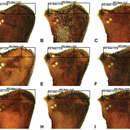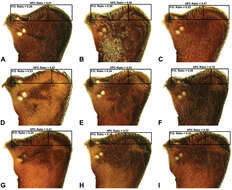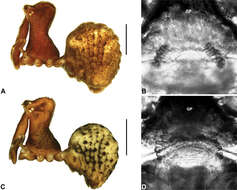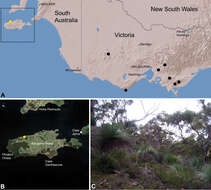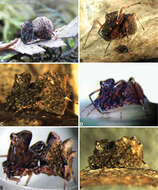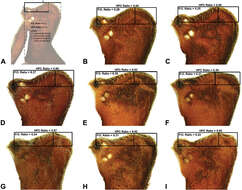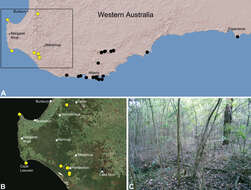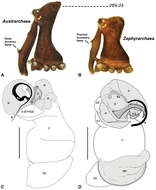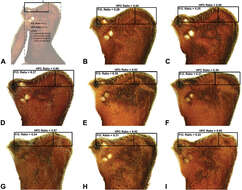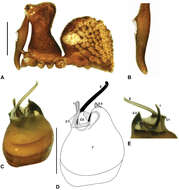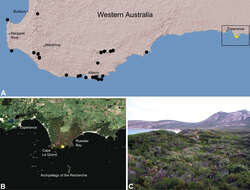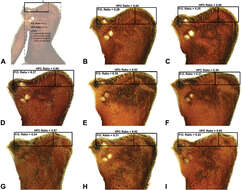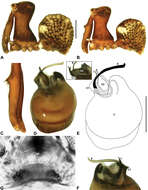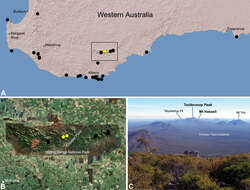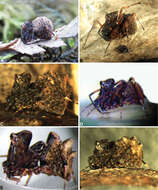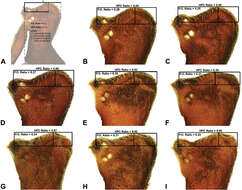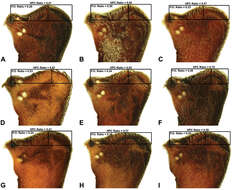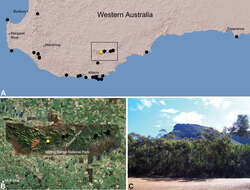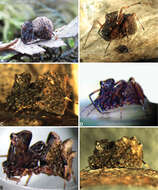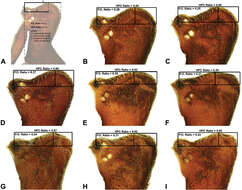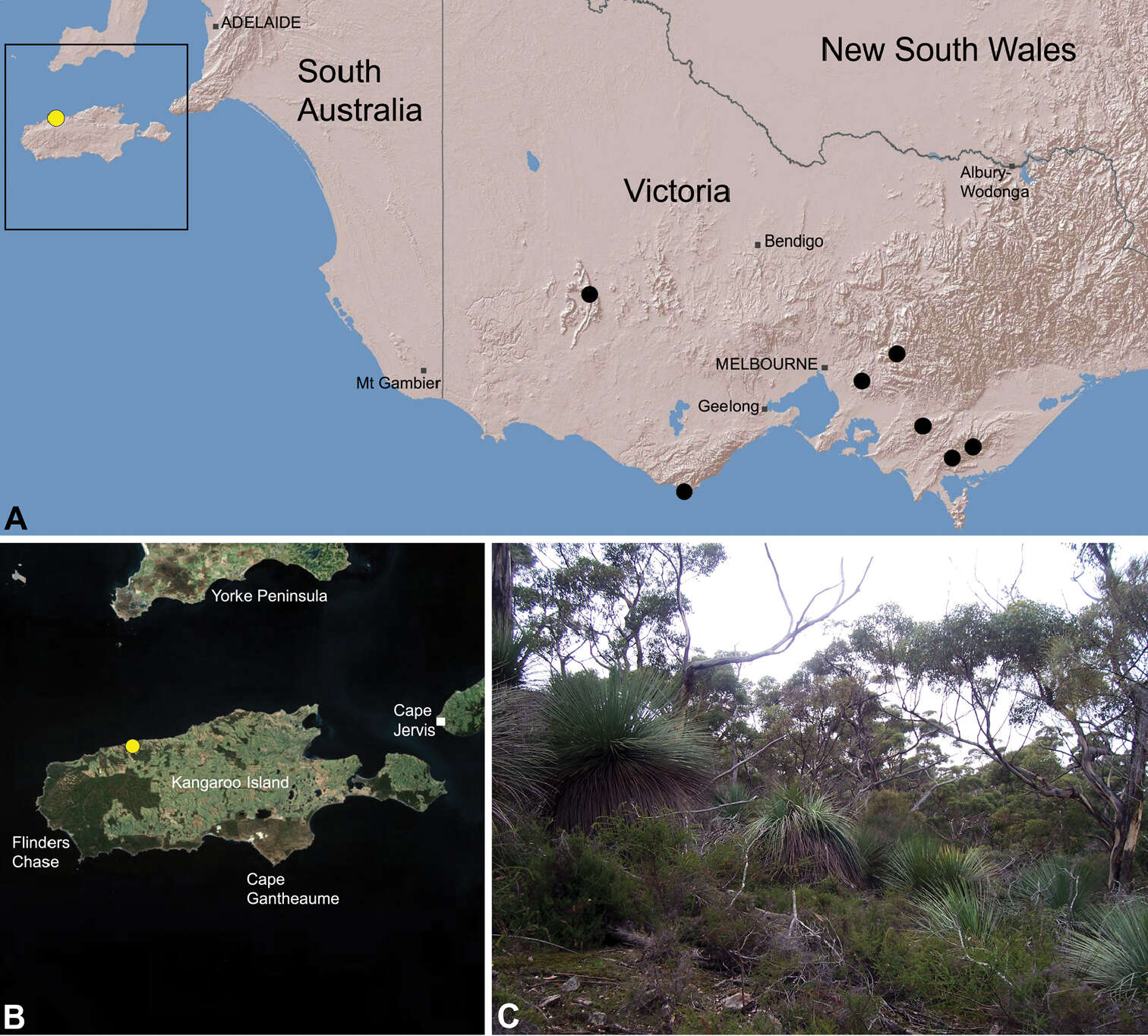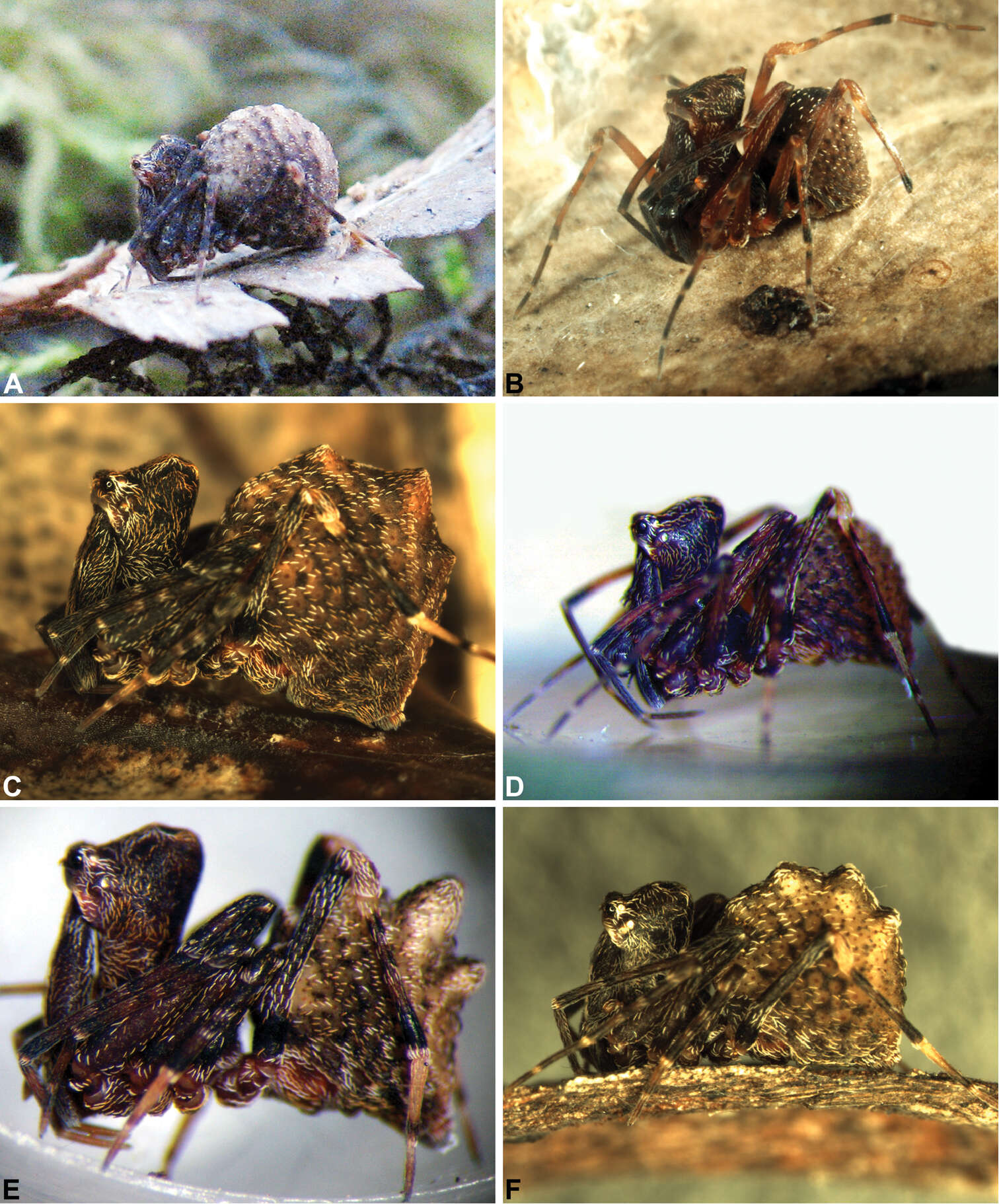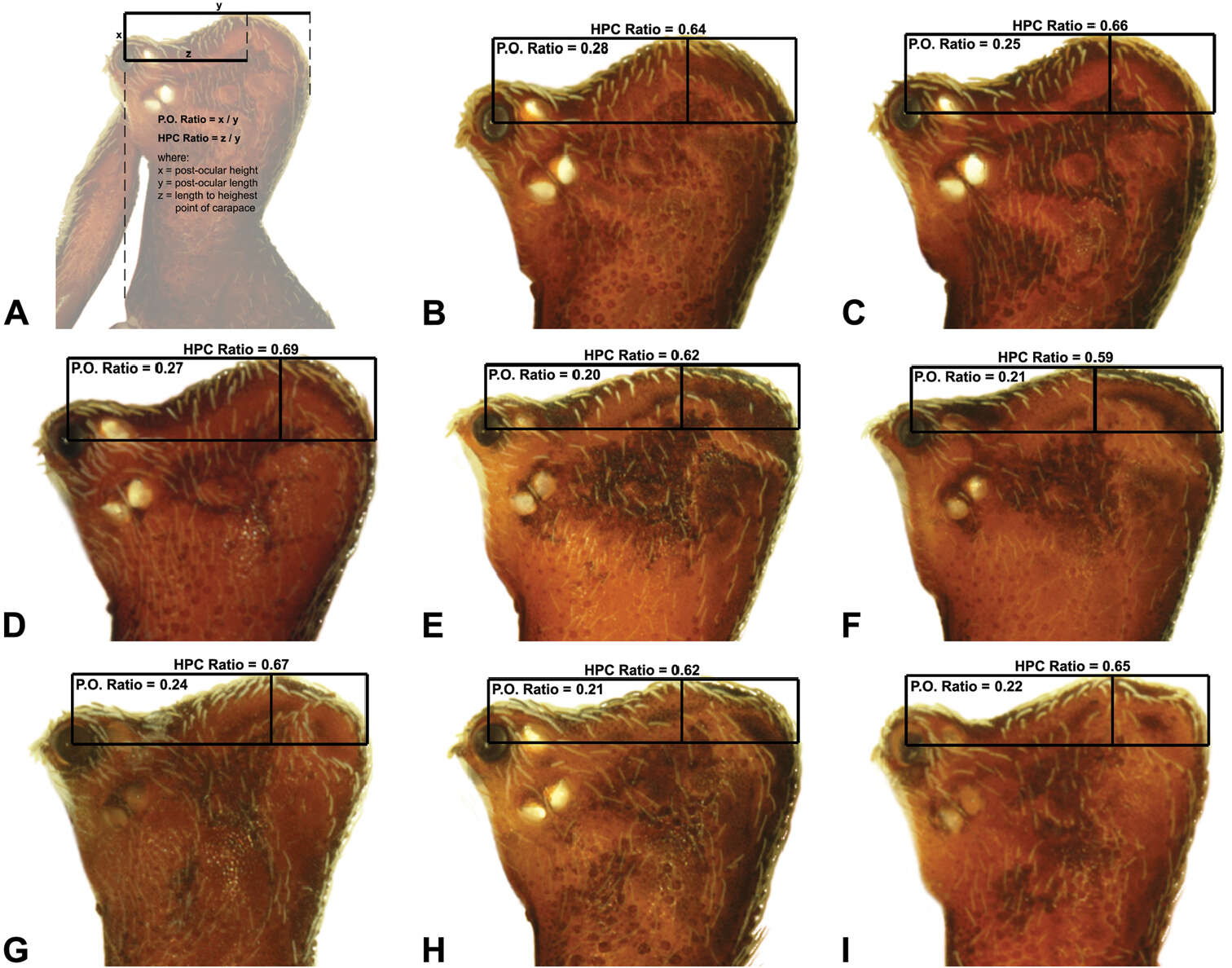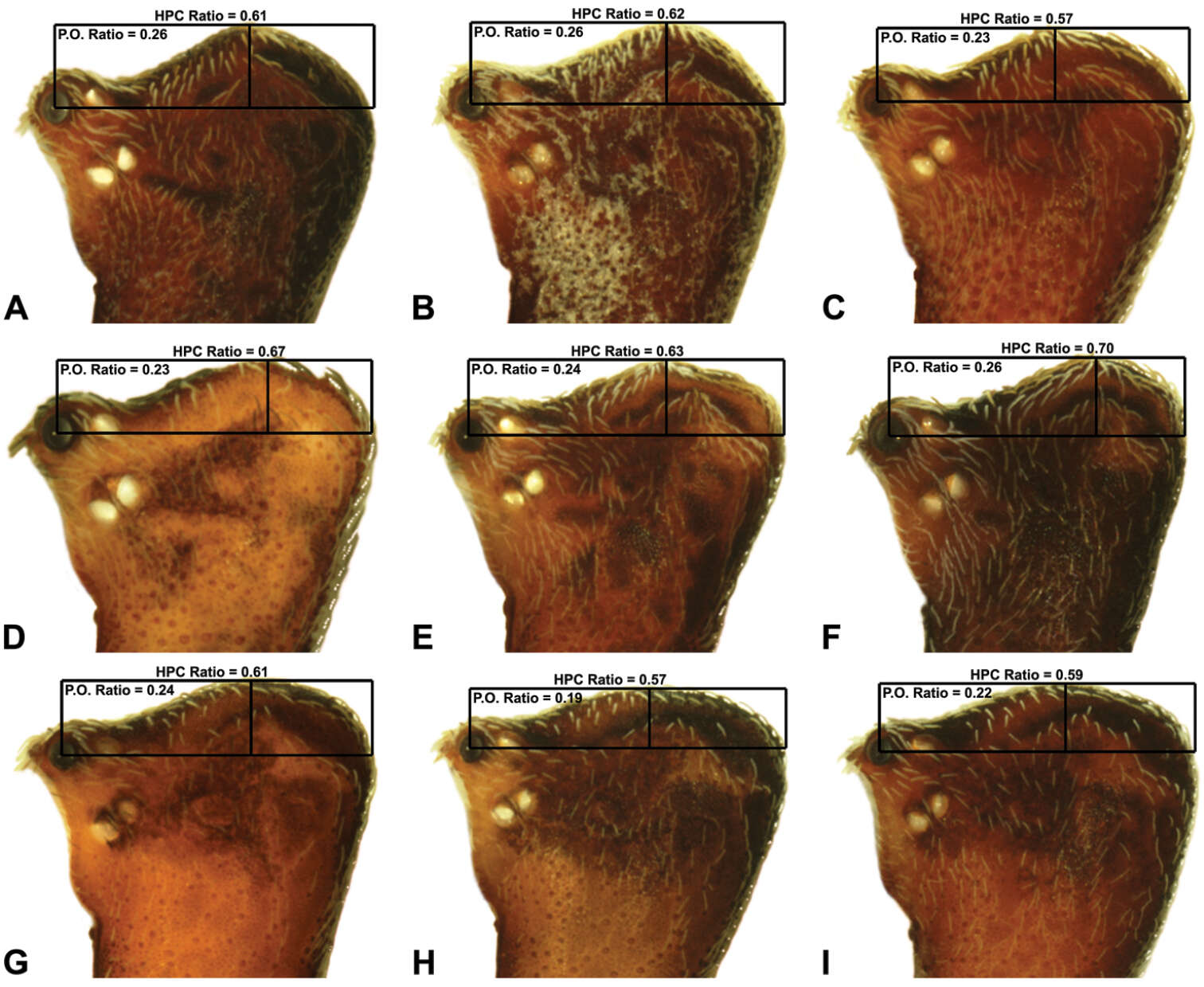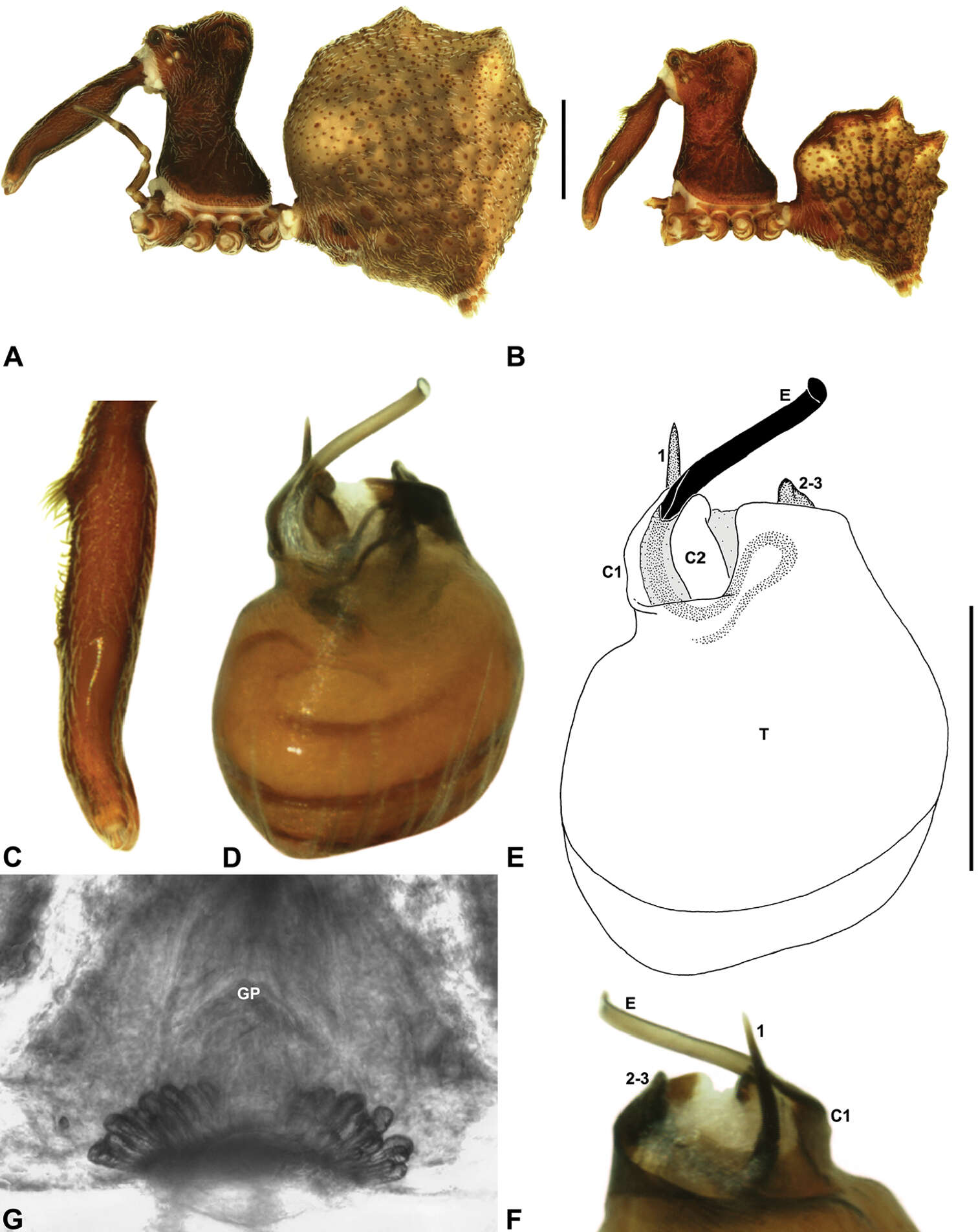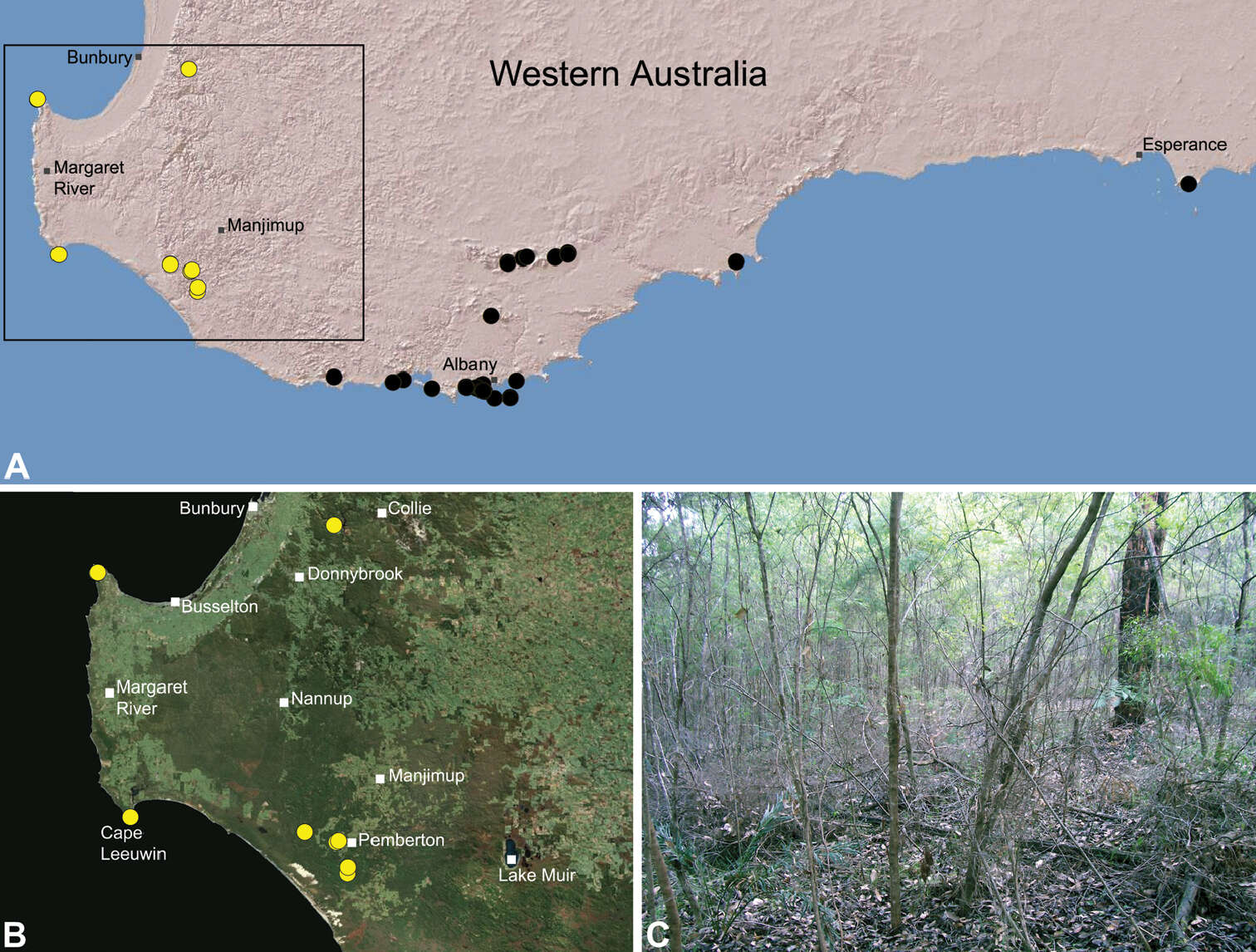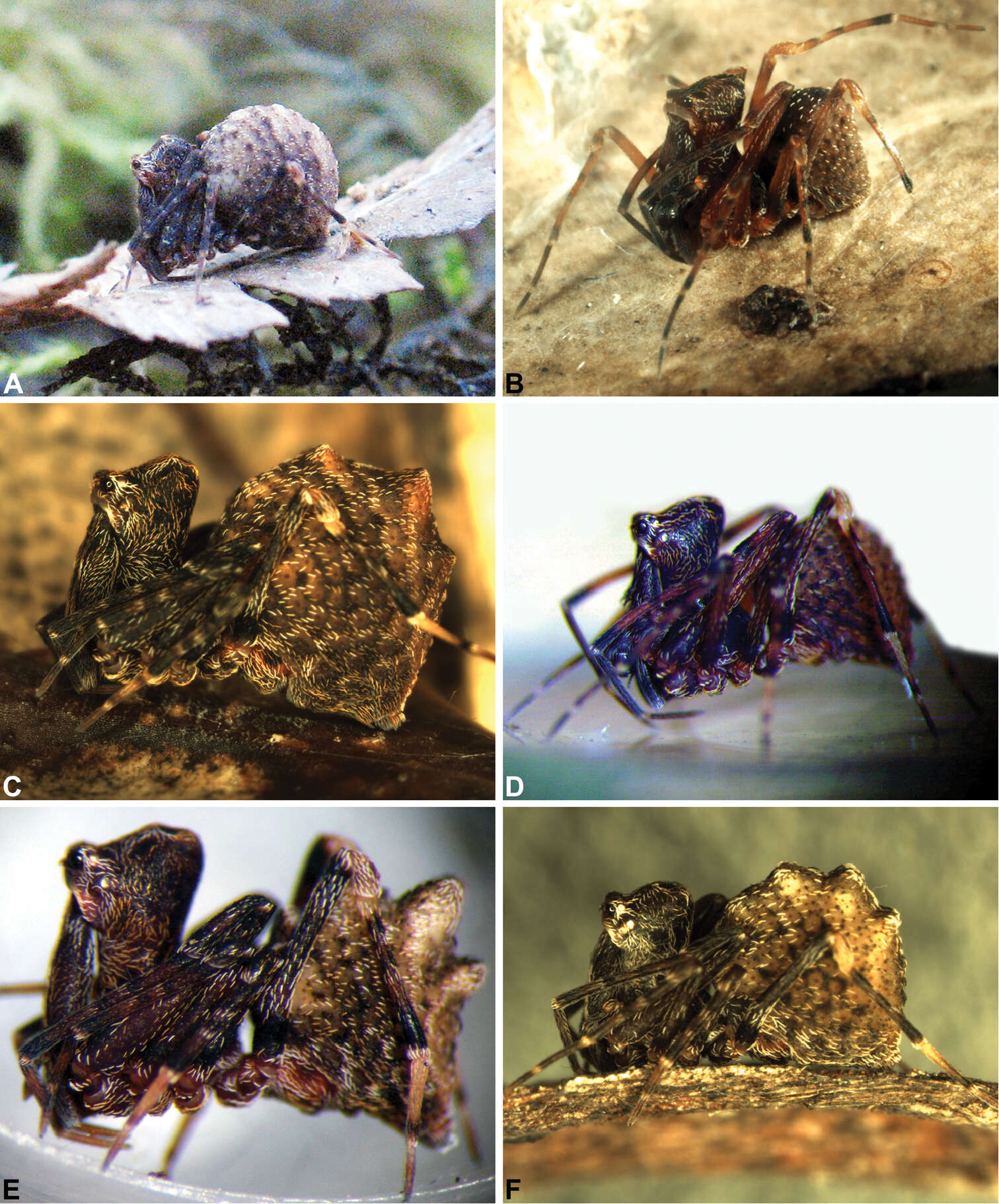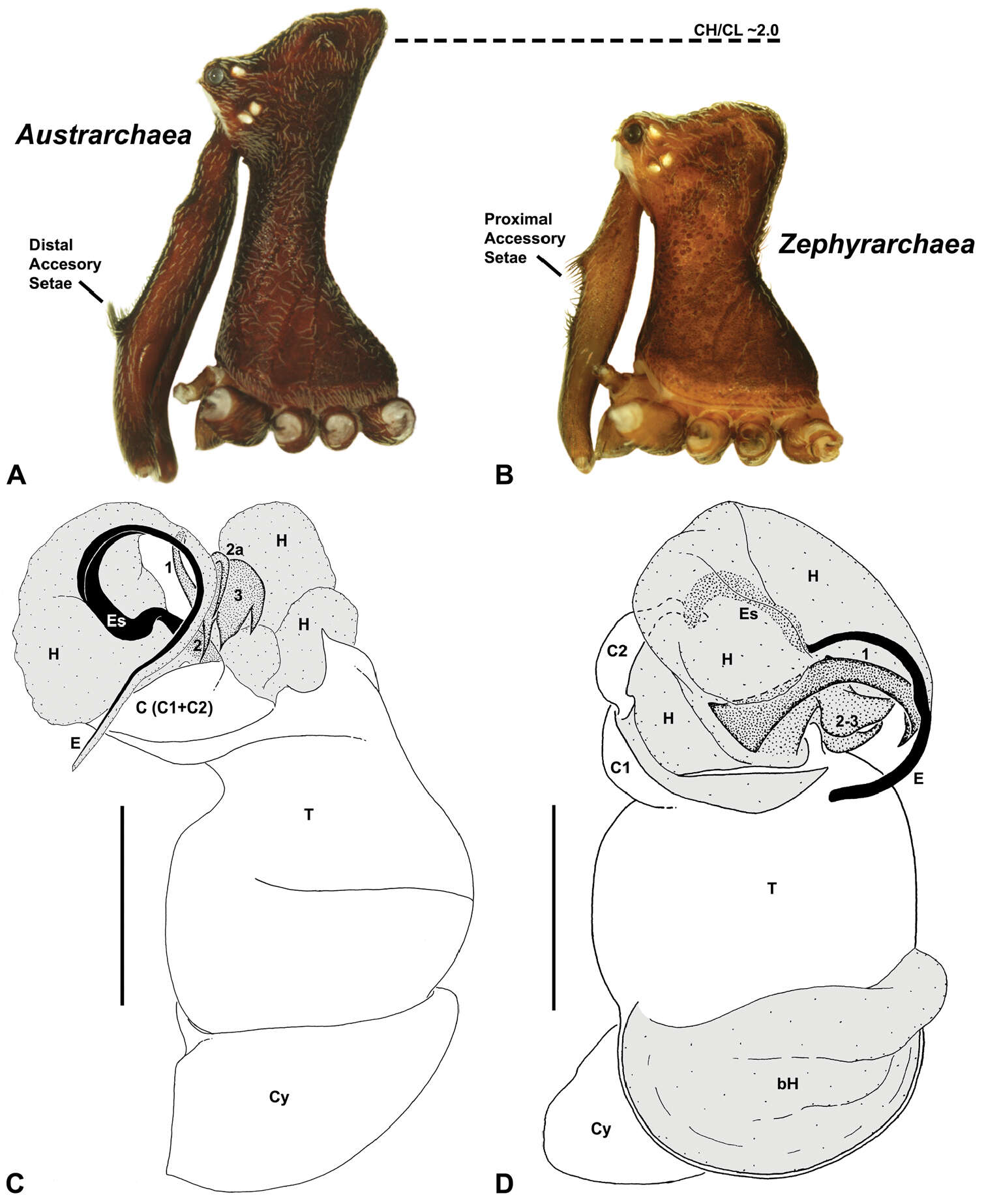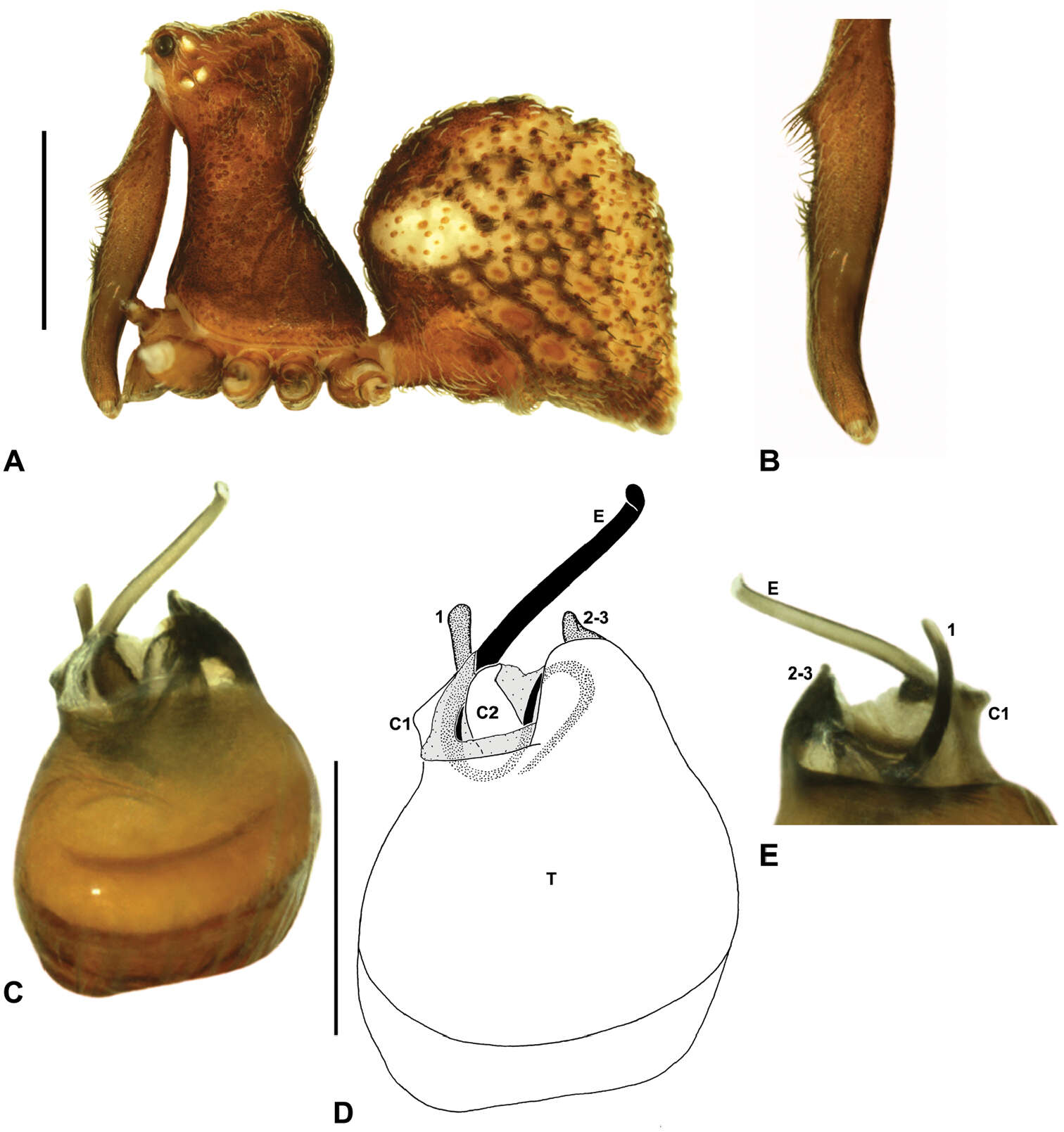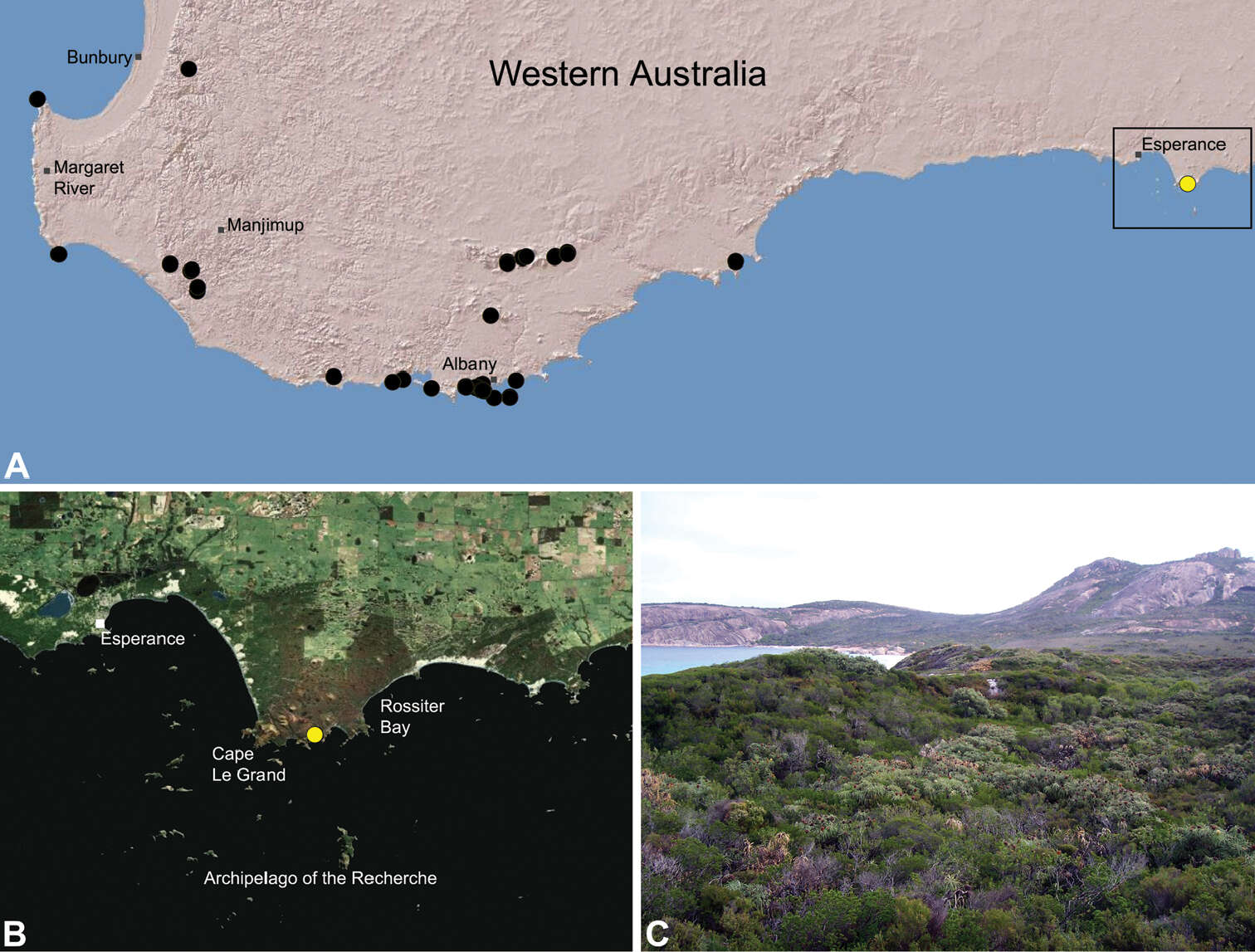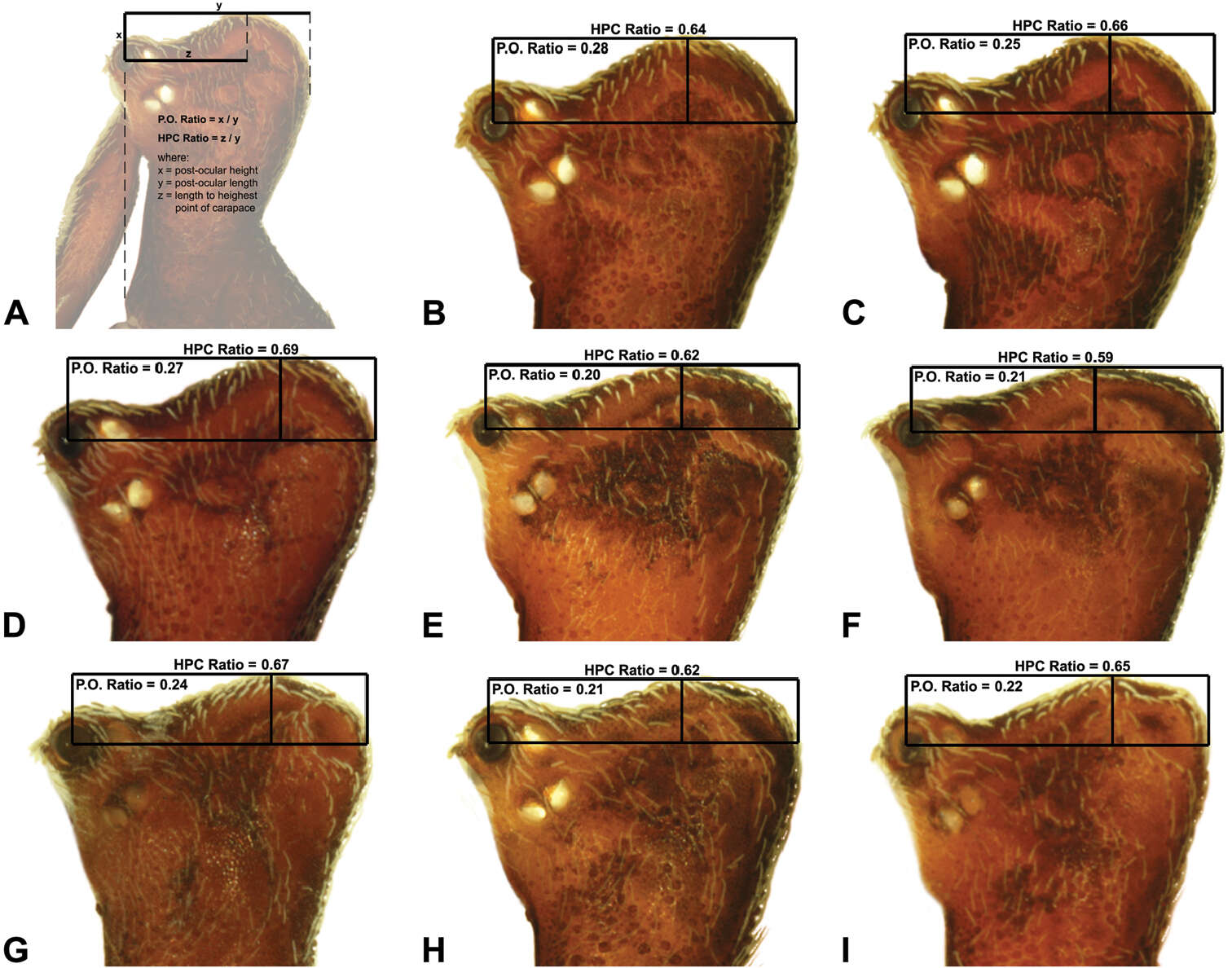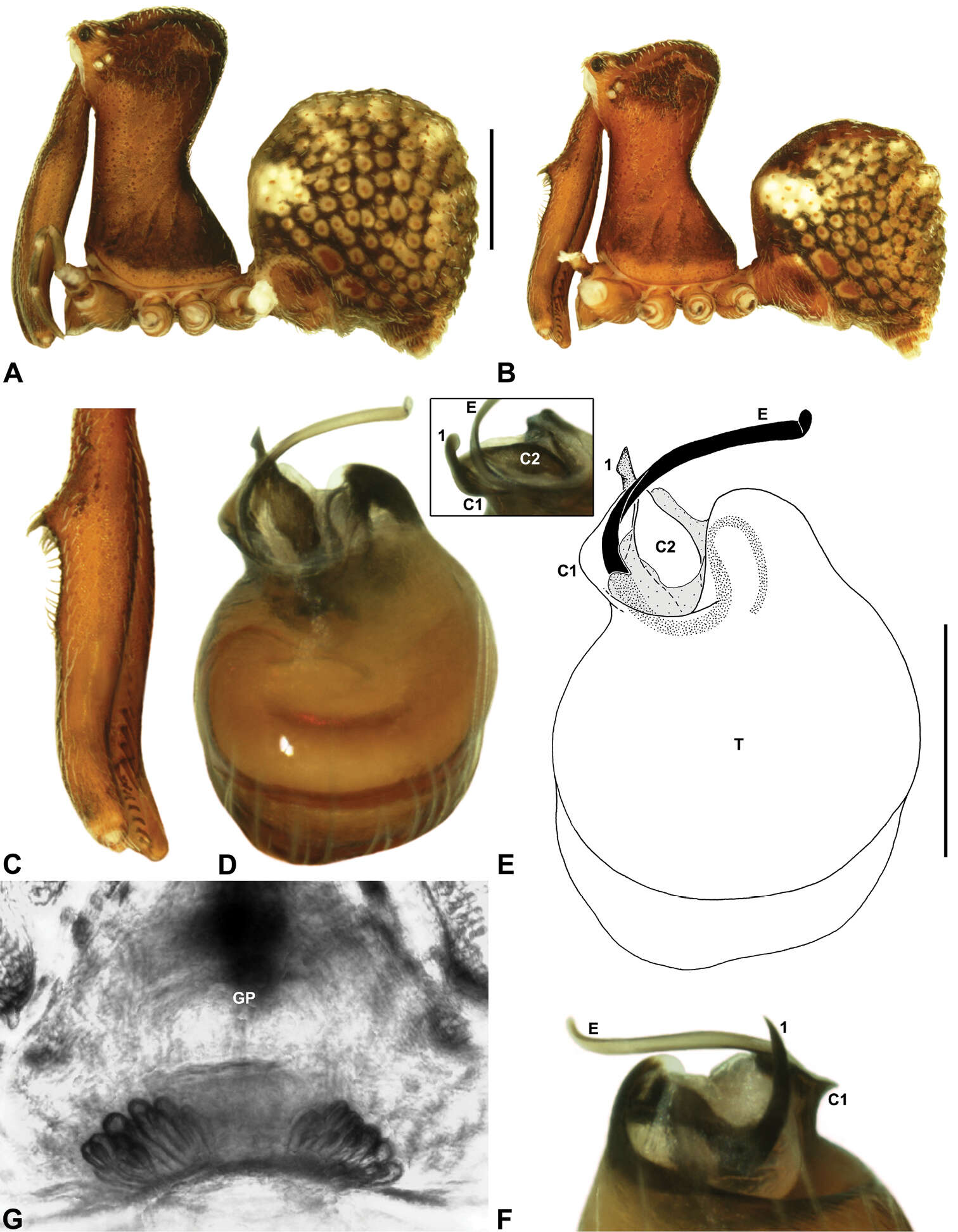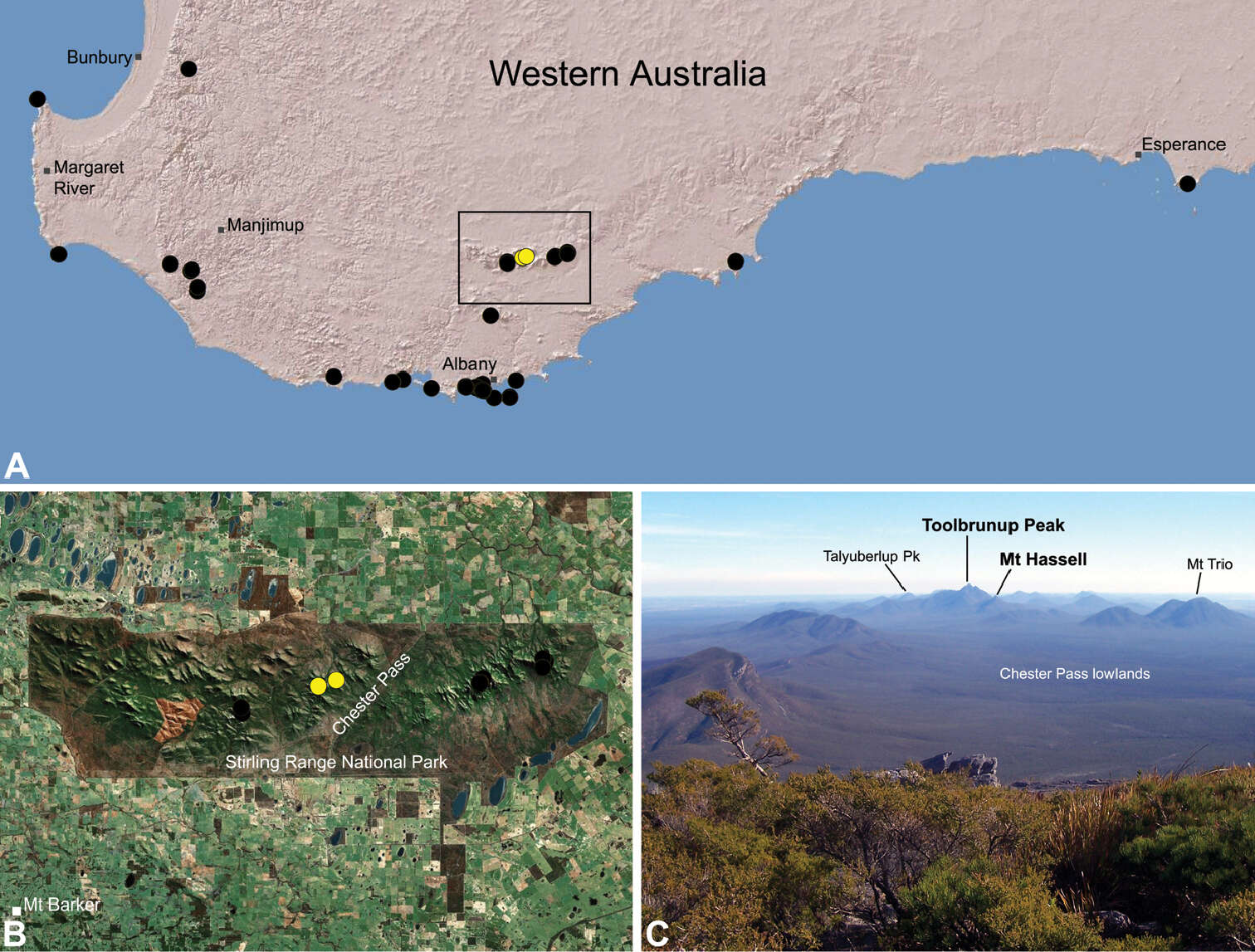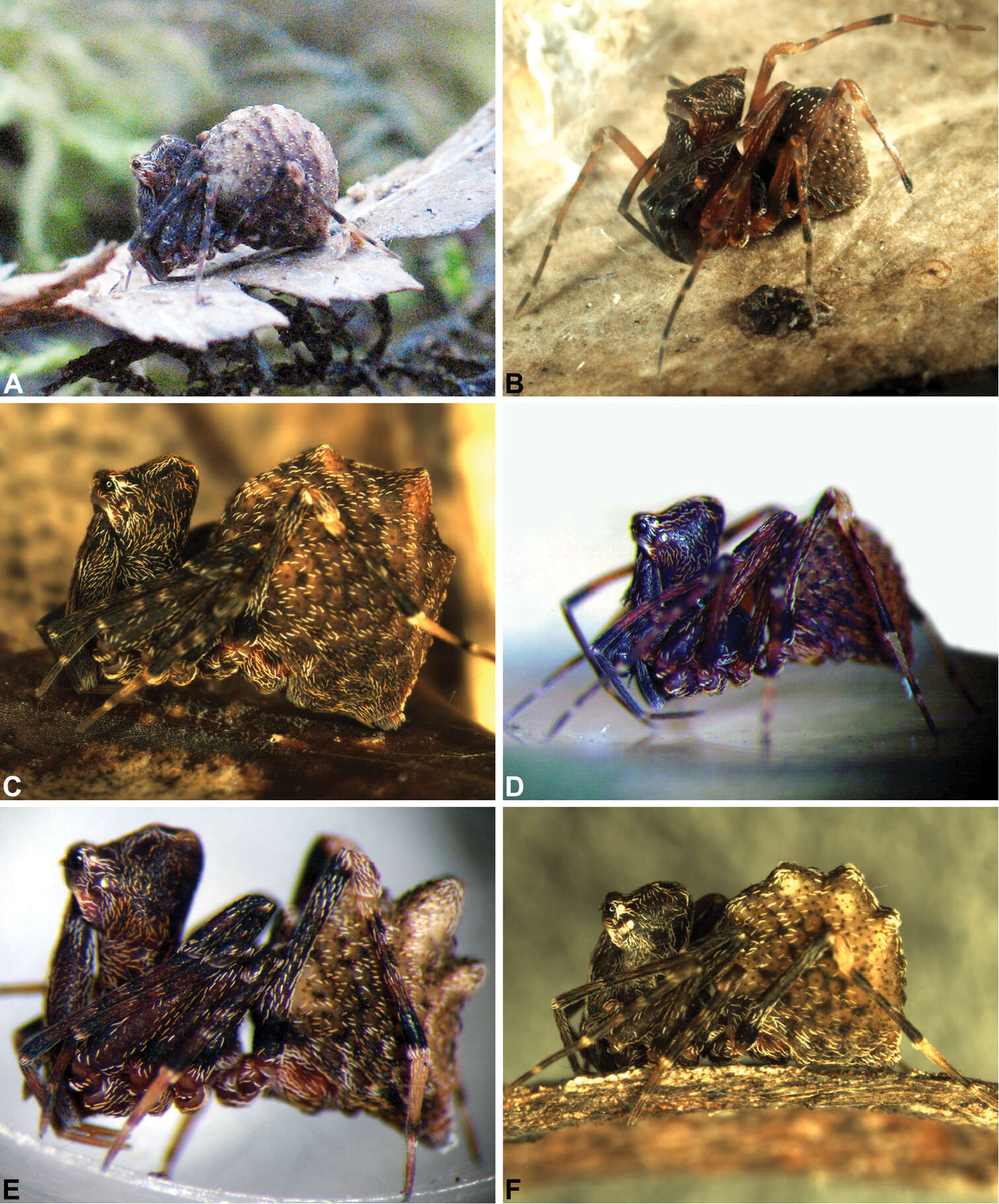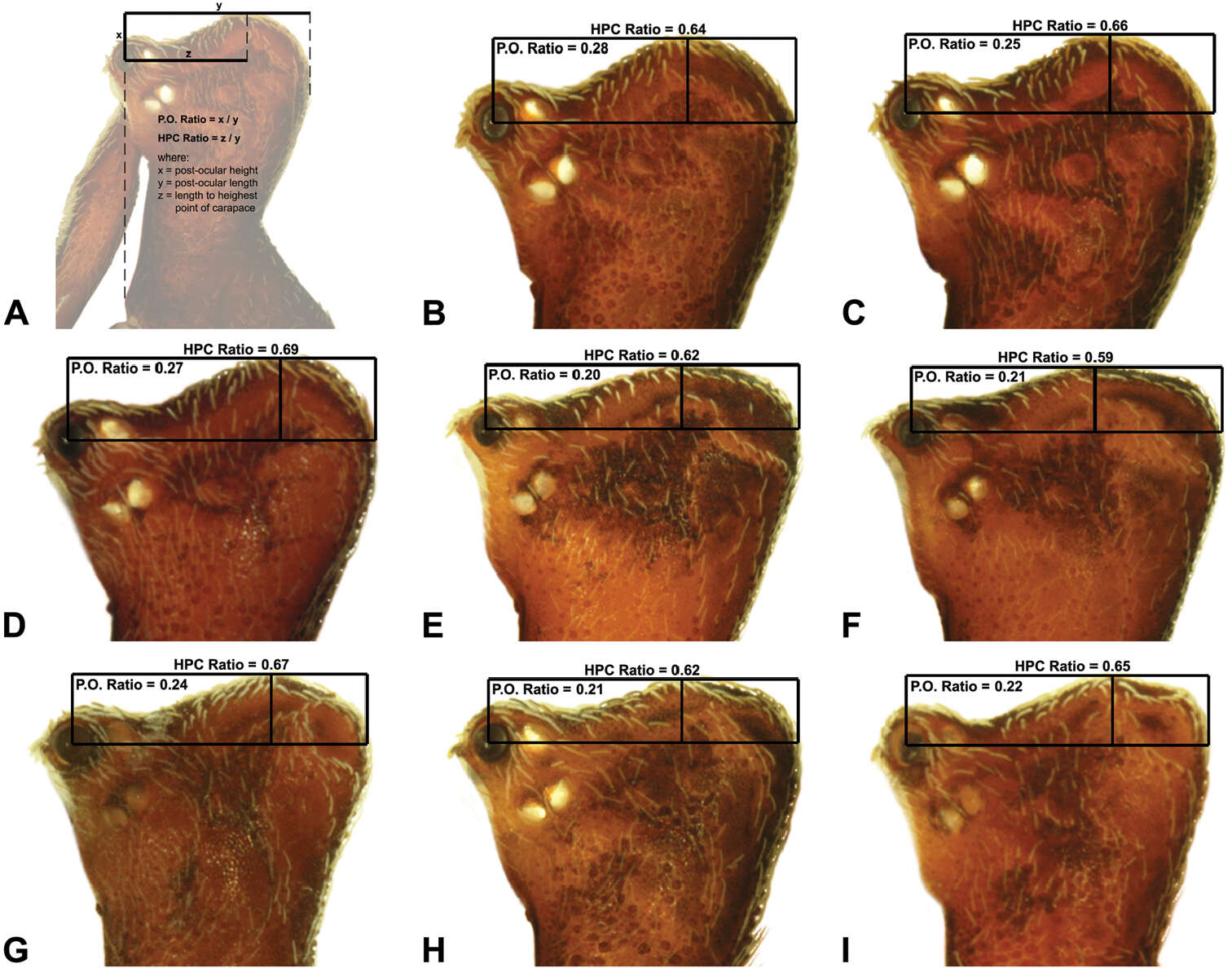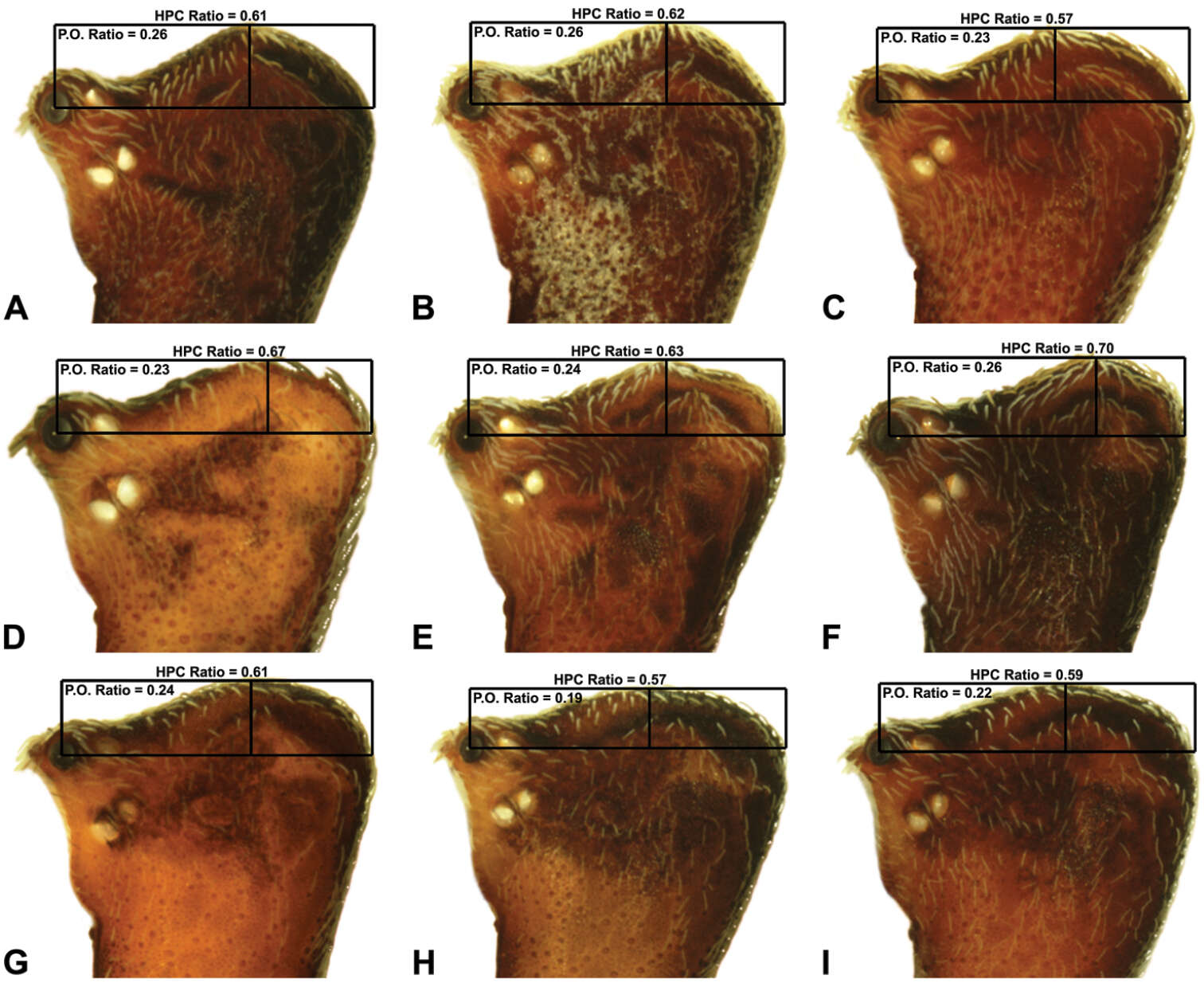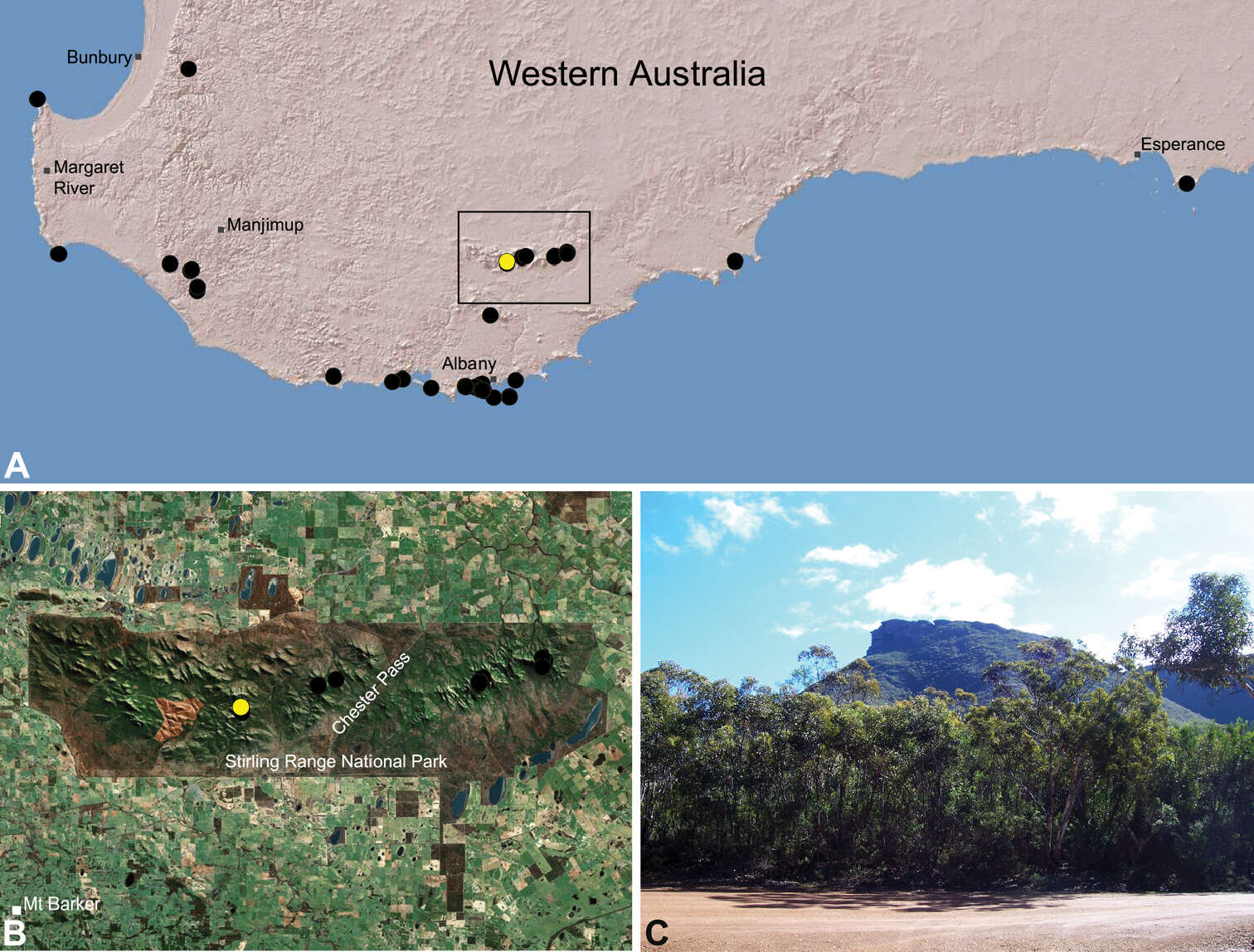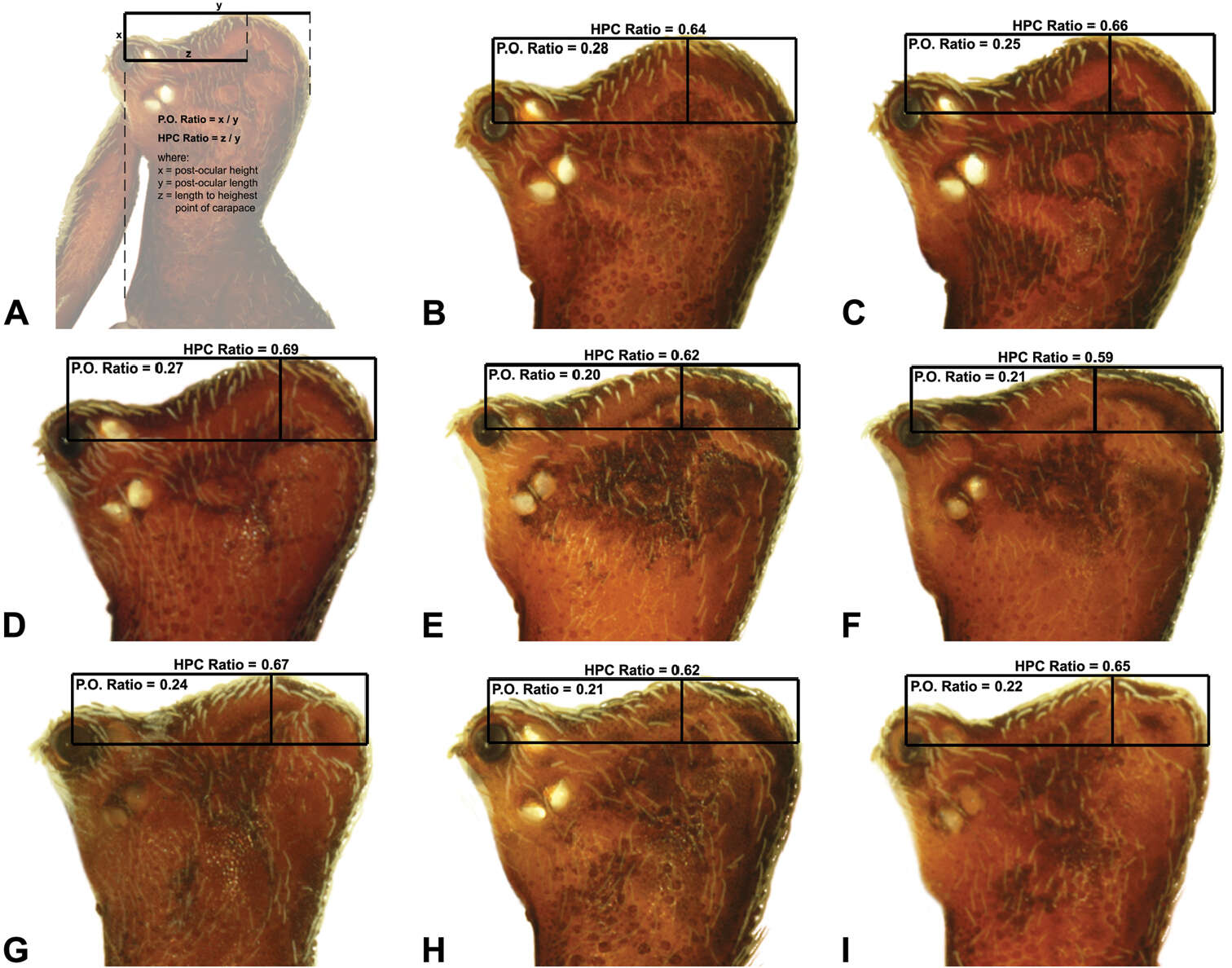-
Michael G. Rix, Mark S. Harvey
Zookeys
Figure 9.Lateral ‘head’ profiles of females of species of Zephyrarchaea, showing variation in carapace shape as quantified by the post-ocular ratio (P.O. Ratio) and ratio of highest point of carapace relative to post-ocular length (HPC Ratio) (see Fig. 8): A, allotype Zephyrarchaea vichickmani sp. n.; B, allotype Zephyrarchaea marae sp. n.; C, holotype Zephyrarchaea grayi sp. n.; D, holotype Zephyrarchaea austini sp. n.; E, Zephyrarchaea mainae (Platnick, 1991b); F, allotype Zephyrarchaea janineae sp. n.; G, holotype Zephyrarchaea robinsi (Harvey, 2002a); H, allotype Zephyrarchaea melindae sp. n.; I, allotype Zephyrarchaea barrettae sp. n.
-
Michael G. Rix, Mark S. Harvey
Zookeys
Figure 19.Zephyrarchaea grayi sp. n. and Zephyrarchaea austini sp. n. A–B, holotype female Zephyrarchaea grayi sp. n. (AMS KS109448) from Delley’s Dell, Grampians National Park, Victoria: A, cephalothorax and abdomen, lateral view; B, internal genitalia, antero-dorsal view. C–D, holotype female Zephyrarchaea austini (SAM NN28000) from Western River Wilderness Protection Area, Kangaroo Island, South Australia: C, cephalothorax and abdomen, lateral view; D, internal genitalia, antero-dorsal view. GP = genital plate. Scale bars: A, C = 1.0 mm.
-
Michael G. Rix, Mark S. Harvey
Zookeys
Figure 30.Zephyrarchaea austini sp. n., distribution and habitat: A, topographic map showing the known distribution of Archaeidae in Victoria and South Australia, with collection localities for Zephyrarchaea austini highlighted in yellow; B, satellite image showing detail of inset (A); C, open eucalypt woodland and heathland at the type locality – near Billy Goat Falls, Western River Wilderness Protection Area, Kangaroo Island, South Australia (May 2010). Image (C) by M. Rix.
-
Michael G. Rix, Mark S. Harvey
Zookeys
Figure 1.Habitus images of live Archaeidae from southern Australia: A paratype female Zephyrarchaea vichickmani sp. n. from Acheron Gap, Central Highlands, Victoria; B holotype male Zephyrarchaea barrettae sp. n. from Talyuberlup Peak, Stirling Range National Park, Western Australia; C paratype female Zephyrarchaea janineae sp. n. from Karri Valley, Western Australia; D male Zephyrarchaea marki sp. n. from Thistle Cove, Cape Le Grand National Park, Western Australia; E female Zephyrarchaea mainae (Platnick) from William Bay National Park, Western Australia; F female Zephyrarchaea mainae from Bremer Bay, Western Australia.
-
Michael G. Rix, Mark S. Harvey
Zookeys
Figure 8.Lateral ‘head’ profiles of males of species of Zephyrarchaea, showing variation in carapace shape as quantified by the post-ocular ratio (P.O. Ratio) and ratio of highest point of carapace relative to post-ocular length (HPC Ratio): A, holotype Zephyrarchaea marae sp. n., showing the derivation of morphometric ratios; B, holotype Zephyrarchaea vichickmani sp. n.; C, holotype Zephyrarchaea marae sp. n.; D, holotype Zephyrarchaea porchi sp. n.; E, holotype Zephyrarchaea melindae sp. n.; F, holotype Zephyrarchaea barrettae sp. n.; G, holotype Zephyrarchaea mainae (Platnick, 1991b); H, holotype Zephyrarchaea marki sp. n.; I, holotype Zephyrarchaea janineae sp. n.
-
Michael G. Rix, Mark S. Harvey
Zookeys
Figure 9.Lateral ‘head’ profiles of females of species of Zephyrarchaea, showing variation in carapace shape as quantified by the post-ocular ratio (P.O. Ratio) and ratio of highest point of carapace relative to post-ocular length (HPC Ratio) (see Fig. 8): A, allotype Zephyrarchaea vichickmani sp. n.; B, allotype Zephyrarchaea marae sp. n.; C, holotype Zephyrarchaea grayi sp. n.; D, holotype Zephyrarchaea austini sp. n.; E, Zephyrarchaea mainae (Platnick, 1991b); F, allotype Zephyrarchaea janineae sp. n.; G, holotype Zephyrarchaea robinsi (Harvey, 2002a); H, allotype Zephyrarchaea melindae sp. n.; I, allotype Zephyrarchaea barrettae sp. n.
-
Michael G. Rix, Mark S. Harvey
Zookeys
Figure 11.Zephyrarchaea janineae sp. n. A–B, Cephalothorax and abdomen, lateral view: A, allotype female (WAM T118981) from Karri Valley, Western Australia; B, holotype male (WAM T89559) from Karri Valley, Western Australia. C, Holotype male chelicerae, lateral view, showing accessory setae. D–F, Holotype male pedipalp: D–E, bulb, retrolateral view; F, detail of distal tegular sclerites, prolateral view. G, Allotype female internal genitalia, dorsal view. C1–2 = conductor sclerites 1–2; E = embolus; GP = genital plate; T = tegulum; (TS)1–3 = tegular sclerites 1–3. Scale bars: A–B = 1.0 mm; E = 0.2 mm.
-
Michael G. Rix, Mark S. Harvey
Zookeys
Figure 21.Zephyrarchaea janineae sp. n., distribution and habitat: A, topographic map showing the known distribution of Archaeidae in south-western Western Australia, with collection localities for Zephyrarchaea janineae highlighted in yellow; B, satellite image showing detail of inset (A); C, wet eucalypt forest at the type locality – Karri Valley, Western Australia (August 2006). Image (C) by M. Rix.
-
Michael G. Rix, Mark S. Harvey
Zookeys
Figure 1.Habitus images of live Archaeidae from southern Australia: A paratype female Zephyrarchaea vichickmani sp. n. from Acheron Gap, Central Highlands, Victoria; B holotype male Zephyrarchaea barrettae sp. n. from Talyuberlup Peak, Stirling Range National Park, Western Australia; C paratype female Zephyrarchaea janineae sp. n. from Karri Valley, Western Australia; D male Zephyrarchaea marki sp. n. from Thistle Cove, Cape Le Grand National Park, Western Australia; E female Zephyrarchaea mainae (Platnick) from William Bay National Park, Western Australia; F female Zephyrarchaea mainae from Bremer Bay, Western Australia.
-
Michael G. Rix, Mark S. Harvey
Zookeys
Figure 4.Diagnostic characters of Zephyrarchaea gen. n. and Austrarchaea Forster & Platnick. A–B, Cephalothorax, lateral view, showing differences in carapace height and the position of accessory setae on male chelicerae: A, male Austrarchaea harmsi Rix & Harvey; B, male Zephyrarchaea marki sp. n. C–D, Expanded male pedipalps, retro-ventral view, showing differences in the articulation and fusion of the conductor sclerites: C, Austrarchaea helenae Rix & Harvey; D, Zephyrarchaea marae sp. n. bH = basal haematodocha; C = conductor; C1–2 = conductor sclerites 1–2; Cy = cymbium; E = embolus; Es = embolic sclerite; H = distal haematodocha; T = tegulum; (TS)1–3 = tegular sclerites 1–3. Scale bars: C–D = 0.2 mm.
-
Michael G. Rix, Mark S. Harvey
Zookeys
Figure 8.Lateral ‘head’ profiles of males of species of Zephyrarchaea, showing variation in carapace shape as quantified by the post-ocular ratio (P.O. Ratio) and ratio of highest point of carapace relative to post-ocular length (HPC Ratio): A, holotype Zephyrarchaea marae sp. n., showing the derivation of morphometric ratios; B, holotype Zephyrarchaea vichickmani sp. n.; C, holotype Zephyrarchaea marae sp. n.; D, holotype Zephyrarchaea porchi sp. n.; E, holotype Zephyrarchaea melindae sp. n.; F, holotype Zephyrarchaea barrettae sp. n.; G, holotype Zephyrarchaea mainae (Platnick, 1991b); H, holotype Zephyrarchaea marki sp. n.; I, holotype Zephyrarchaea janineae sp. n.
-
Michael G. Rix, Mark S. Harvey
Zookeys
Figure 12.Zephyrarchaea marki sp. n. A–E, Holotype male (WAM T118985) from Thistle Cove, Cape Le Grand National Park, Western Australia: A, cephalothorax and abdomen, lateral view; B, chelicerae, lateral view, showing accessory setae; C–D, pedipalpal bulb, retrolateral view; E, detail of distal tegular sclerites, prolateral view. C1–2 = conductor sclerites 1–2; E = embolus; T = tegulum; (TS)1–3 = tegular sclerites 1–3. Scale bars: A = 1.0 mm; D = 0.2 mm.
-
Michael G. Rix, Mark S. Harvey
Zookeys
Figure 22.Zephyrarchaea marki sp. n., distribution and habitat: A, topographic map showing the known distribution of Archaeidae in south-western Western Australia, with collection localities for Zephyrarchaea marki highlighted in yellow; B, satellite image showing detail of inset (A); C, temperate coastal heathland at the type locality – Thistle Cove, Cape Le Grand National Park, Western Australia (June 2010). Image (C) by M. Rix.
-
Michael G. Rix, Mark S. Harvey
Zookeys
Figure 8.Lateral ‘head’ profiles of males of species of Zephyrarchaea, showing variation in carapace shape as quantified by the post-ocular ratio (P.O. Ratio) and ratio of highest point of carapace relative to post-ocular length (HPC Ratio): A, holotype Zephyrarchaea marae sp. n., showing the derivation of morphometric ratios; B, holotype Zephyrarchaea vichickmani sp. n.; C, holotype Zephyrarchaea marae sp. n.; D, holotype Zephyrarchaea porchi sp. n.; E, holotype Zephyrarchaea melindae sp. n.; F, holotype Zephyrarchaea barrettae sp. n.; G, holotype Zephyrarchaea mainae (Platnick, 1991b); H, holotype Zephyrarchaea marki sp. n.; I, holotype Zephyrarchaea janineae sp. n.
-
Michael G. Rix, Mark S. Harvey
Zookeys
Figure 9.Lateral ‘head’ profiles of females of species of Zephyrarchaea, showing variation in carapace shape as quantified by the post-ocular ratio (P.O. Ratio) and ratio of highest point of carapace relative to post-ocular length (HPC Ratio) (see Fig. 8): A, allotype Zephyrarchaea vichickmani sp. n.; B, allotype Zephyrarchaea marae sp. n.; C, holotype Zephyrarchaea grayi sp. n.; D, holotype Zephyrarchaea austini sp. n.; E, Zephyrarchaea mainae (Platnick, 1991b); F, allotype Zephyrarchaea janineae sp. n.; G, holotype Zephyrarchaea robinsi (Harvey, 2002a); H, allotype Zephyrarchaea melindae sp. n.; I, allotype Zephyrarchaea barrettae sp. n.
-
Michael G. Rix, Mark S. Harvey
Zookeys
Figure 14.Zephyrarchaea melindae sp. n. A–B, Cephalothorax and abdomen, lateral view: A, allotype female (WAM T97468) from Toolbrunup Peak, Stirling Range National Park, Western Australia; B, holotype male (WAM T118986) from Mount Hassell, Stirling Range National Park, Western Australia. C, Holotype male chelicerae, lateral view, showing accessory setae. D–F, Holotype male pedipalp: D–E, bulb, retrolateral view, with inset showing twisted apex of tegular sclerite 1 in retroventral view; F, detail of distal tegular sclerites, prolateral view. G, Allotype female internal genitalia, dorsal view. C1–2 = conductor sclerites 1–2; E = embolus; GP = genital plate; T = tegulum; (TS)1 = tegular sclerite 1. Scale bars: A–B = 1.0 mm; E = 0.2 mm.
-
Michael G. Rix, Mark S. Harvey
Zookeys
Figure 24.Zephyrarchaea melindae sp. n., distribution and habitat: A, topographic map showing the known distribution of Archaeidae in south-western Western Australia, with collection localities for Zephyrarchaea melindae highlighted in yellow; B, satellite image showing detail of inset (A); C, view from the summit of Bluff Knoll across the western Stirling Range National Park, showing collection localities for Zephyrarchaea melindae (i.e. Toolbrunup Peak, Mount Hassell) highlighted in bold (June 2010). Note the Chester Pass lowlands, separating populations of Zephyrarchaea melindae and Zephyrarchaea robinsi, and Talyuberlup Peak in the distance, home to Zephyrarchaea barrettae sp. n. Image (C) by M. Rix.
-
Michael G. Rix, Mark S. Harvey
Zookeys
Figure 1.Habitus images of live Archaeidae from southern Australia: A paratype female Zephyrarchaea vichickmani sp. n. from Acheron Gap, Central Highlands, Victoria; B holotype male Zephyrarchaea barrettae sp. n. from Talyuberlup Peak, Stirling Range National Park, Western Australia; C paratype female Zephyrarchaea janineae sp. n. from Karri Valley, Western Australia; D male Zephyrarchaea marki sp. n. from Thistle Cove, Cape Le Grand National Park, Western Australia; E female Zephyrarchaea mainae (Platnick) from William Bay National Park, Western Australia; F female Zephyrarchaea mainae from Bremer Bay, Western Australia.
-
Michael G. Rix, Mark S. Harvey
Zookeys
Figure 8.Lateral ‘head’ profiles of males of species of Zephyrarchaea, showing variation in carapace shape as quantified by the post-ocular ratio (P.O. Ratio) and ratio of highest point of carapace relative to post-ocular length (HPC Ratio): A, holotype Zephyrarchaea marae sp. n., showing the derivation of morphometric ratios; B, holotype Zephyrarchaea vichickmani sp. n.; C, holotype Zephyrarchaea marae sp. n.; D, holotype Zephyrarchaea porchi sp. n.; E, holotype Zephyrarchaea melindae sp. n.; F, holotype Zephyrarchaea barrettae sp. n.; G, holotype Zephyrarchaea mainae (Platnick, 1991b); H, holotype Zephyrarchaea marki sp. n.; I, holotype Zephyrarchaea janineae sp. n.
-
Michael G. Rix, Mark S. Harvey
Zookeys
Figure 9.Lateral ‘head’ profiles of females of species of Zephyrarchaea, showing variation in carapace shape as quantified by the post-ocular ratio (P.O. Ratio) and ratio of highest point of carapace relative to post-ocular length (HPC Ratio) (see Fig. 8): A, allotype Zephyrarchaea vichickmani sp. n.; B, allotype Zephyrarchaea marae sp. n.; C, holotype Zephyrarchaea grayi sp. n.; D, holotype Zephyrarchaea austini sp. n.; E, Zephyrarchaea mainae (Platnick, 1991b); F, allotype Zephyrarchaea janineae sp. n.; G, holotype Zephyrarchaea robinsi (Harvey, 2002a); H, allotype Zephyrarchaea melindae sp. n.; I, allotype Zephyrarchaea barrettae sp. n.
-
Michael G. Rix, Mark S. Harvey
Zookeys
Figure 15.Zephyrarchaea barrettae sp. n. A–B, Cephalothorax and abdomen, lateral view: A, allotype female (WAM T97466) from Talyuberlup Peak, Stirling Range National Park, Western Australia; B, holotype male (WAM T117055) from Talyuberlup Peak, Stirling Range National Park, Western Australia. C, Holotype male chelicerae, lateral view, showing accessory setae. D–F, Holotype male pedipalp: D–E, bulb, retrolateral view, with inset showing twisted apex of tegular sclerite 1 in retroventral view; F, detail of distal tegular sclerites, prolateral view. G, Allotype female internal genitalia, dorsal view. C1–2 = conductor sclerites 1–2; E = embolus; GP = genital plate; H = distal haematodocha; T = tegulum; (TS)1 = tegular sclerite 1. Scale bars: A–B = 1.0 mm; E = 0.2 mm.
-
Michael G. Rix, Mark S. Harvey
Zookeys
Figure 25.Zephyrarchaea barrettae sp. n., distribution and habitat: A, topographic map showing the known distribution of Archaeidae in south-western Western Australia, with collection localities for Zephyrarchaea barrettae highlighted in yellow; B, satellite image showing detail of inset (A); C, view from Stirling Range Drive showing the type locality – Talyuberlup Peak, Stirling Range National Park (August 2008). Image (C) by M. Rix.
-
Michael G. Rix, Mark S. Harvey
Zookeys
Figure 1.Habitus images of live Archaeidae from southern Australia: A paratype female Zephyrarchaea vichickmani sp. n. from Acheron Gap, Central Highlands, Victoria; B holotype male Zephyrarchaea barrettae sp. n. from Talyuberlup Peak, Stirling Range National Park, Western Australia; C paratype female Zephyrarchaea janineae sp. n. from Karri Valley, Western Australia; D male Zephyrarchaea marki sp. n. from Thistle Cove, Cape Le Grand National Park, Western Australia; E female Zephyrarchaea mainae (Platnick) from William Bay National Park, Western Australia; F female Zephyrarchaea mainae from Bremer Bay, Western Australia.
-
Michael G. Rix, Mark S. Harvey
Zookeys
Figure 8.Lateral ‘head’ profiles of males of species of Zephyrarchaea, showing variation in carapace shape as quantified by the post-ocular ratio (P.O. Ratio) and ratio of highest point of carapace relative to post-ocular length (HPC Ratio): A, holotype Zephyrarchaea marae sp. n., showing the derivation of morphometric ratios; B, holotype Zephyrarchaea vichickmani sp. n.; C, holotype Zephyrarchaea marae sp. n.; D, holotype Zephyrarchaea porchi sp. n.; E, holotype Zephyrarchaea melindae sp. n.; F, holotype Zephyrarchaea barrettae sp. n.; G, holotype Zephyrarchaea mainae (Platnick, 1991b); H, holotype Zephyrarchaea marki sp. n.; I, holotype Zephyrarchaea janineae sp. n.

